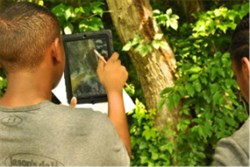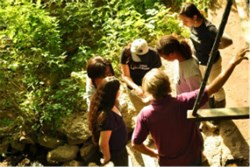Full Transparency
Our editorial transparency tool uses blockchain technology to permanently log all changes made to official releases after publication. However, this post is not an official release and therefore not tracked. Visit our learn more for more information.
Seventh and eighth-grade students at Charles Carroll Middle School in New Carrollton, Md., had a unique opportunity to participate in the school’s first schoolyard bioblitz last week (June 5). With the help of National Geographic Education, the American Association for the Advancement of Science (AAAS) and the Verizon Foundation, students were able to observe and identify 48 different living species of plants, animals and insects in the area around their school, which is part of the Chesapeake Bay Watershed.
Students worked with scientists and employed mobile devices to identify and archive species using mobile apps and online tools, such as National Geographic’s Project Noah, Leaf Snap and Chesapeake Bay FieldScope, to enhance the students’ hands-on biodiversity survey.

“Mobile technology is a critical component of a bioblitz because it allows students to learn in real-time, when their interest is high, with the help of scientists and naturalists around the world,” said Justina Nixon-Saintil, director-education of the Verizon Foundation. “For example, students could take photos of leaves with their smartphones, and the Leaf Snap app suggests the types of trees the leaves are part of. With Project Noah, students were able to get help from scientists in identifying the crayfish they found in the small stream behind their school.”
During the bioblitz, students and science teachers split into groups and rotated through three stations dedicated to inventorying the species that live on the perimeter of the school’s grounds. By the end of the two-hour event, students found 48 different species, including sour grass, wild mulberries, white and red oaks, nine different birds, snail eggs, leeches, crayfish and 16 different insects including a number of different bees. Students used their tablets to capture photos of the different species they found, and uploaded the images to their Project Noah mission to serve as a baseline for the next bioblitz the school conducts.

Students were fortunate to have help in the field from several scientists who assisted them in identifying species and understanding the importance (or detriment) of each one in the overall ecosystem. The scientists included Dr. Marc Imlay, conservation biologist and plant specialist for Prince George’s County Parks; Sam Droege, biologist and insect specialist for the U.S. Geological Survey Patuxent Wildlife Research Center; Dejen Mengis, biology student at the University of Maryland and assistant to Droege; and Elena Takaki, environmental scientist for National Geographic Education's Chesapeake Bay FieldScope Program.
Charles Carroll is one of 12 schools chosen from across the nation to participate in the Verizon Innovative Learning Schools (VILS) program. The VILS initiative includes an intensive professional development program for teachers focused on the use of mobile devices in the classroom to transform teaching and learning in the subjects of science, technology, engineering and math (STEM). As the first year of the program comes to an end, the teachers and students will put into action what they learned and use mobile technology to survey the biodiversity in their own schoolyard.
A bioblitz is a 24-hour event in which teams of volunteer scientists, families, students, teachers, and other community members work together to find and identify as many species of plants, animals, microbes, fungi and other organisms as possible. The National Geographic Society, in conjunction with the National Park Service, is helping conduct a bioblitz in a different national park each year during the decade leading up to the U.S. National Park Service Centennial in 2016. The Charles Carroll Middle School schoolyard bioblitz is a pilot program with the goal of supporting teachers and students in a smaller-scale biodiversity count.
